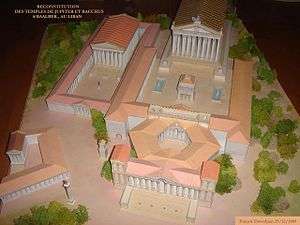Hippodrome of Berytus
The hippodrome of Berytus was a circus in the Roman colony of Berytus (modern-day Beirut). It is one of two hippodromes in Beirut.
Discovered in 1988 in Wadi Abu Jamil, the historic Jewish quarter of Beirut, close to the Roman port and forum, the hippodrome of Berytus was the second to be discovered in Lebanon after the Tyre Hippodrome.[1] It was one of the largest in the Levant, occupying an area of 3500 m2,[1] and was probably similar to the Circus Maximus in Rome. The Expositio—written in the second half of the fourth century by an unknown writer about circuses and circus games in the Roman empire—names the five best racecourses in the Levant as Berytus, Antioch, Laodicea, Caesarea and Tyrus.[2] The hippodrome of Berytus is considered to have been the grandest of the five, containing amphitheatres that are several meters high and a 90-meter-long race track.[3]
During the 6th and the 7th centuries, the activities in hippodromes across the Byzantine Empire were banned under the pressure of the Eastern Orthodox Church, so the structure fell in disrepair and later, under Arab rule, its stones were reused for the construction of other buildings.
Preservation
In 2009 the site was officially listed in the general inventory of historic buildings, and the Culture Minister Tamam Salam ruled that it should be preserved in situ and turned into a tourist landmark.[3]
According to an article appearing in the French daily, L’Orient le Jour, Gaby Layoun, the Culture Minister at the time, approved in March 2012 plans for a luxury residential complex to be built over the ruins of Beirut’s Roman Hippodrome, bypassing the recommendations of three of his predecessors: Tarek Mitri, Salim Wardé, and Tammam Salam.[4][5] The Association for the Protection of the Lebanese Heritage (APLH) organized protests as an attempt to reverse the Culture Ministry's decision to allow the building over the hippodrome.[6] Following the litigation brought by the Association for the Protection of Lebanese Heritage (APLH), the court suspended on May 31, 2012 the Culture Ministry's decision, N˚ 849, to dismantle the Roman Hippodrome that would have allowed for the construction of a building project on the site.[7] The site was protected until 2015 when construction began again.
See also
Notes
- 1 2 http://stateofmind13.com/2012/03/18/save-beiruts-heritage-the-roman-hippodrome-to-be-demolished/
- ↑ John Humphrey, "Berytus hippodrome on "Roman Circuses: Arenas for Chariot Racing". p. 441
- 1 2 http://english.al-akhbar.com/content/minister-culture-dismantles-beiruts-roman-hippodrome
- ↑ http://www.lorientlejour.com/category/%C3%80+La+Une/article/750188/L'hippodrome_romain_de_Beyrouth_englouti_par_les_promoteurs.html
- ↑ The three previous Culture Ministers, Mitri, Wardé, and Salam criticized Layoun's move and reiterated the importance of protecting and preserving the archeological site (http://www.nowlebanon.com/NewsArchiveDetails.aspx?ID=395164) A march to protest the destruction of the hippodrome took place on March 24, 2012 (https://www.facebook.com/events/395461473816530/)
- ↑ http://english.al-akhbar.com/content/protest-called-protect-lebanese-ancient-ruins
- ↑ http://libnanews.com/2012/05/31/hippodrome-romain-de-beyrouth-la-justice-suspend-la-decision-de-demantelement/
Bibliography
- Humphrey, JH. Roman Circuses: Arenas for Chariot Racing. University of California. Los Angeles, 1986 ISBN 9780520049215
